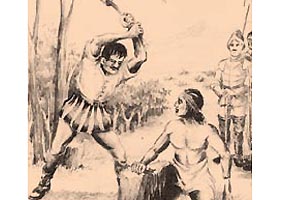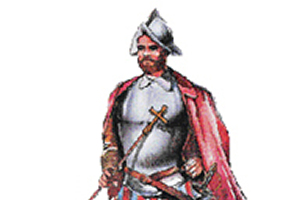Colo Colo was born around 1490 near the valley next to Cañete (region of Biobio). In 1553, when he was a popular sixty year old among mapuches, he organized them to choose a military chief capable of making up the initial defeats dealt by the Spanish in the war of Arauco. He also tried to appease internal rivalries among the mapuches.
This is how, along with Lautaro and Caupolican, they defeated the Spanish led by Pedro de Valdivia at the battle of Tucapel (December 25th, 1553) and afterwards, Caupolican sacked and burned down the city of Concepcion, driving the Spanish from the place.
After this episode, Colo Colo’s protagonism continued in the war of Arauco for several more years, because Caupolican’s imprisonment and Lautaro’s death made him the leader. It is said he signed a partial truce with Spaniard Garcia Hurtado de Mendoza (1559), constituting the first written treaty signed among them.
Some historians say he died the year after the battle of Quipeo (1560) and others say he passed away during the government of Rodrigo de Quiroga (1565-1567) after signing provisional peace with the Spanish.
Caupolican
He was born in Pilmaiquen, but his date of birth is uncertain. He fought the Spanish for the freedom of his land since a young age. One of his first battles was Tucapel (1553), where Pedro de Valdivia died. The following year, he took several cities founded by the Spanish.
After the death of Lautaro (1557), the mapuches were left without a leader, proof of which was seen at the battle of Lagunilla (September 5th, 1557), where 12,000 indigenous people under the command of several caciques were defeated by 600 Spanish soldiers and some 1,500 yanaconas.
The attack left hundreds of dead and wounded and 150 prisoners. Among the latter was cacique (chief) Galvarino; both of his hand were mutilated. After this event, Caupolican became supreme chief of the mapuches and continued the fight against the Spanish.
After the victory of Spanish weapons at Lagunillas, it was followed by Millarapue (November 30th, 1557). In this battle, the mapuches, commanded by Caupolican, attempted a surprise attack on the enemy’s camp, which was under the command of governor Garcia Hurtado de Mendoza, but they reacted in time and once again defeated Caupolican.
Caupolican did not surrender, and on January 20th, 1558, he attacked the Spanish at fort Cañete with 15,000 combatants. They retuned the blow fiercely, causing the panicked escape of the mapuches to the hills.
After the attack on fort Cañete, an advanced team from the command of Spaniard Pedro de Velasco y Avendaño arrived to Pilmaiquen and captured Caupolican at Antihuala, who was preparing a counteroffensive (February 5th, 1558).
The cacique was taken to Cañete before Alonso de Reinoso, who sentenced him to die on the pike (a death caused by the penetration of a wooden tip into the intestines).
Caupolican was raised to the platform and tied at its center, where the one in charge of carrying out the order was field marshal Cristobal de Arevalo.








